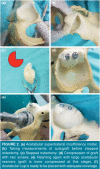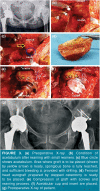Stepped osteotomy of femoral head autograft for acetabular reconstruction in total hip arthroplasty for dysplasia of the hip: 3 to 12 years' results
- PMID: 32584737
- PMCID: PMC7489182
- DOI: 10.5606/ehc.2020.74300
Stepped osteotomy of femoral head autograft for acetabular reconstruction in total hip arthroplasty for dysplasia of the hip: 3 to 12 years' results
Abstract
Objectives: This study aims to describe a stepped osteotomy technique applied to the femoral head autograft to keep the graft volume at a sufficient level, provide primary stability, and direct cancellous-cancellous bone contact.
Patients and methods: In this retrospective study, 24 hips of 20 patients (5 males, 15 females; mean age 53 years; range, 43 to 68 years) with dysplasia of the hip (DDH) who underwent total hip arthroplasty with femoral head stepped osteotomy technique were evaluated between April 2003 and June 2010. Patients' age, gender, operation side, and postoperative complications were recorded. Aseptic loosening of the acetabular cup and graft integration/resorption were evaluated radiographically. Radiological evaluations were performed according to the methods of DeLee and Charnley, and Mulroy and Harris. Functional status of the patients was determined according to the criteria of Merle d'Aubigné and Postel, and Harris hip score (HHS).
Results: The mean follow-up period was 5.5 years (range, 3 to 12 years). None of the patients had any complications in the early postoperative period. In all patients, the percentage of acetabular component coverage by the graft was measured as 27% (range, 19 to 38%) on average. At the last follow-up, all patients were satisfied with the result and there was no sign of clinically loosening, osteointegration was complete, and there was no radiographic evidence of graft resorption or collapse of any hip. The overall Merle d'Aubigné scores and HHSs of the patients significantly improved at the final follow-up.
Conclusion: This stepped osteotomy technique increases the probability of osteointegration, reduces the need for early revision, and provides reliable stability with satisfactory clinical and radiological midterm results.
Conflict of interest statement
Figures






Similar articles
-
One-third of Hips After Periacetabular Osteotomy Survive 30 Years With Good Clinical Results, No Progression of Arthritis, or Conversion to THA.Clin Orthop Relat Res. 2017 Apr;475(4):1154-1168. doi: 10.1007/s11999-016-5169-5. Clin Orthop Relat Res. 2017. PMID: 27905061 Free PMC article.
-
Reconstruction of the Shallow Acetabulum With a Combination of Autologous Bulk and Impaction Bone Grafting Fixed by Cement.Clin Orthop Relat Res. 2017 Feb;475(2):387-395. doi: 10.1007/s11999-016-5107-6. Clin Orthop Relat Res. 2017. PMID: 27837399 Free PMC article.
-
Impingement adversely affects 10-year survivorship after periacetabular osteotomy for DDH.Clin Orthop Relat Res. 2013 May;471(5):1602-14. doi: 10.1007/s11999-013-2799-8. Epub 2013 Jan 25. Clin Orthop Relat Res. 2013. PMID: 23354462 Free PMC article.
-
Periacetabular osteotomy in the treatment of severe acetabular dysplasia. Surgical technique.J Bone Joint Surg Am. 2006 Mar;88 Suppl 1 Pt 1:65-83. doi: 10.2106/JBJS.E.00887. J Bone Joint Surg Am. 2006. PMID: 16510801 Review.
-
Long-term outcomes of the hip shelf arthroplasty in adolescents and adults with residual hip dysplasia: a systematic review.Acta Orthop. 2020 Aug;91(4):383-389. doi: 10.1080/17453674.2020.1747210. Epub 2020 Apr 2. Acta Orthop. 2020. PMID: 32237929 Free PMC article.
Cited by
-
Mid-Term Outcomes of Cemented Stem and Subtrochanteric Shortening Derotational Osteotomy in Total Hip Arthroplasty for Crowe IV Developmental Dysplasia.Orthop Surg. 2022 Dec;14(12):3178-3186. doi: 10.1111/os.13515. Epub 2022 Oct 17. Orthop Surg. 2022. PMID: 36250564 Free PMC article.
-
Does the use of robotic technology in hip arthroplasty provide superior clinical outcomes?Jt Dis Relat Surg. 2022;33(1):253-254. doi: 10.52312/jdrs.2022.57904. Epub 2022 Mar 28. Jt Dis Relat Surg. 2022. PMID: 35361104 Free PMC article. No abstract available.
-
The roof step cut: A novel technique for bony reconstruction of acetabular roof deficiency during total hip replacement.Jt Dis Relat Surg. 2022;33(1):9-16. doi: 10.52312/jdrs.2022.266. Epub 2022 Mar 25. Jt Dis Relat Surg. 2022. PMID: 35361075 Free PMC article.
-
[Short-term effectiveness of structural bone graft and total hip arthroplasty through direct anterior approach in lateral decubitus position for Crowe type Ⅲ and Ⅳ developmental dysplasia of the hip].Zhongguo Xiu Fu Chong Jian Wai Ke Za Zhi. 2022 Sep 15;36(9):1084-1089. doi: 10.7507/1002-1892.202205117. Zhongguo Xiu Fu Chong Jian Wai Ke Za Zhi. 2022. PMID: 36111469 Free PMC article. Chinese.
-
[Biomechanical research progress of common acetabular reconstruction techniques for Crowe type Ⅱ and Ⅲ developmental dysplasia of the hip].Zhongguo Xiu Fu Chong Jian Wai Ke Za Zhi. 2023 Mar 15;37(3):353-359. doi: 10.7507/1002-1892.202211052. Zhongguo Xiu Fu Chong Jian Wai Ke Za Zhi. 2023. PMID: 36940996 Free PMC article. Chinese.
References
-
- Harris WH, Crothers O, Oh I. Total hip replacement and femoral-head bone-grafting for severe acetabular deficiency in adults. J Bone Joint Surg [Am] 1977;59:752–759. - PubMed
-
- Gerber SD, Harris WH. Femoral head autografting to augment acetabular deficiency in patients requiring total hip replacement. A minimum five-year and an average seven-year follow-up study. J Bone Joint Surg [Am] 1986;68:1241–1248. - PubMed
-
- Shinar AA, Harris WH. Bulk structural autogenous grafts and allografts for reconstruction of the acetabulum in total hip arthroplasty. Sixteen-year-average follow-up J Bone Joint Surg [Am] 1997;79:159–168. - PubMed
-
- Iida H, Matsusue Y, Kawanabe K, Okumura H, Yamamuro T, Nakamura T. Cemented Total Hip Arthroplasty With Acetabular Bone Graft for Developmental Dysplasia. Long- term Results and Survivorship Analysis. J Bone Joint Surg [Br] 2000;82:176–184. - PubMed
MeSH terms
LinkOut - more resources
Full Text Sources
Medical
Research Materials
Miscellaneous

